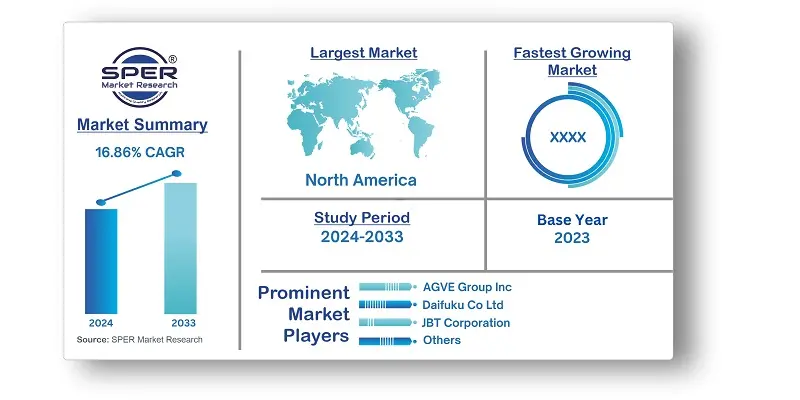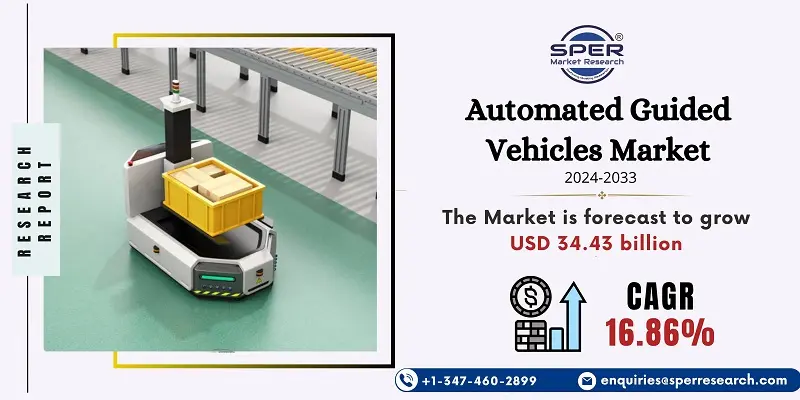
Automated Guided Vehicles Market Growth, Size, Trends, Demand, Revenue and Future Outlook
Automated Guided Vehicles Market Size- By Type, By Navigation Technology, By Application- Regional Outlook, Competitive Strategies and Segment Forecast to 2033
| Published: Sep-2024 | Report ID: AMIN24191 | Pages: 1 - 231 | Formats*: |
| Category : Automotive & Transportation | |||
- In June 2023; Dematic sent off its third-age freezer-rated automated guided vehicles highlighting progressed sensor and route innovations that outperform refreshed worldwide security norms. Planned and inherent in Australia, Dematic's whole scope of AGVs, including high-reach and offset models, are presently reasonable for cooler conditions.
- In April 2023; Germany, Oceaneering's Mobile Robotics group bunch presented new administrative programming for its independent versatile robots. This stage oversees planned operations by organizing robots and fringe gadgets, supporting blended armadas in a single area. As indicated by Patrick Bruijn, the product offers protected, dependable information for better independent direction and is appropriate for different applications, using cloud, IIoT, AI, and large information innovations for security and versatility.


| Report Metric | Details |
| Market size available for years | 2020-2033 |
| Base year considered | 2023 |
| Forecast period | 2024-2033 |
| Segments covered | By Type, By Navigation Technology, By Application |
| Regions covered | North America, Asia-Pacific, Latin America, Middle East & Africa and Europe |
| Companies Covered | AGVE Group Inc, Daifuku Co Ltd, JBT Corporation, Kion Group AG, Kuka AG, Murata Machinery, and Omron Adept Technologies Inc. |
- Manufacturing Plants
- Warehouses and Distribution Centres
- Automotive Industries
- Healthcare Facilities
- Retail Sector
- Airports and Ports
- Pharmaceutical industry
| By Type: |
|
| By Navigation Technology: |
|
| By Application: |
|
- Global Automated Guided Vehicles Market Size (FY’2024-FY’2033)
- Overview of Global Automated Guided Vehicles Market
- Segmentation of Global Automated Guided Vehicles Market By Type (Tow Vehicles, Unit Load Carriers, Pallet Trucks, Assembly Line Vehicles, Others)
- Segmentation of Global Automated Guided Vehicles Market By Navigation Technology (Laser Guidance, Magnetic Guidance, Inductive Guidance, Others)
- Segmentation of Global Automated Guided Vehicles Market By Application (Logistics & Warehousing, Assembly, Packaging, Raw Material Handling, Others)
- Statistical Snap of Global Automated Guided Vehicles Market
- Expansion Analysis of Global Automated Guided Vehicles Market
- Problems and Obstacles in Global Automated Guided Vehicles Market
- Competitive Landscape in the Global Automated Guided Vehicles Market
- Impact of COVID-19 and Demonetization on Global Automated Guided Vehicles Market
- Details on Current Investment in Global Automated Guided Vehicles Market
- Competitive Analysis of Global Automated Guided Vehicles Market
- Prominent Players in the Global Automated Guided Vehicles Market
- SWOT Analysis of Global Automated Guided Vehicles Market
- Global Automated Guided Vehicles Market Future Outlook and Projections (FY’2024-FY’2033)
- Recommendations from Analyst
1.1. Scope of the report1.2. Market segment analysis
2.1. Research data source2.1.1. Secondary Data2.1.2. Primary Data2.1.3. SPER’s internal database2.1.4. Premium insight from KOL’s2.2. Market size estimation2.2.1. Top-down and Bottom-up approach2.3. Data triangulation
4.1. Driver, Restraint, Opportunity and Challenges analysis4.1.1. Drivers4.1.2. Restraints4.1.3. Opportunities4.1.4. Challenges4.2. COVID-19 Impacts of the Global Automated Guided Vehicle Market
5.1. SWOT Analysis5.1.1. Strengths5.1.2. Weaknesses5.1.3. Opportunities5.1.4. Threats5.2. PESTEL Analysis5.2.1. Political Landscape5.2.2. Economic Landscape5.2.3. Social Landscape5.2.4. Technological Landscape5.2.5. Environmental Landscape5.2.6. Legal Landscape5.3. PORTER’s Five Forces5.3.1. Bargaining power of suppliers5.3.2. Bargaining power of buyers5.3.3. Threat of Substitute5.3.4. Threat of new entrant5.3.5. Competitive rivalry5.4. Heat Map Analysis
6.1. Global Automated Guided Vehicle Market Manufacturing Base Distribution, Sales Area, Product Type6.2. Mergers & Acquisitions, Partnerships, Product Launch, and Collaboration in Global Automated Guided Vehicle Market
7.1. Global Automated Guided Vehicle Market Size, Share and Forecast, By Type, 2020-20267.2. Global Automated Guided Vehicle Market Size, Share and Forecast, By Type, 2027-20337.3. Assembly Line Vehicles7.4. Pallet Trucks7.5. Tow Vehicles7.6. Unit Load Carriers7.7. Others
8.1. Global Automated Guided Vehicle Market Size, Share and Forecast, By Navigation Technology, 2020-20268.2. Global Automated Guided Vehicle Market Size, Share and Forecast, By Navigation Technology, 2027-20338.3. Laser Guidance8.4. Magnetic Guidance8.5. Inductive Guidance8.6. Others
9.1. Global Automated Guided Vehicle Market Size, Share and Forecast, By Application, 2020-20269.2. Global Automated Guided Vehicle Market Size, Share and Forecast, By Application, 2027-20339.3. Logistics & Warehousing9.4. Assembly9.5. Packaging9.6. Raw Material Handling9.7. Others
10.1. Global Automated Guided Vehicle Market Size and Market Share
11.1. Global Automated Guided Vehicle Market Size and Market Share By Region (2020-2026)11.2. Global Automated Guided Vehicle Market Size and Market Share By Region (2027-2033)11.3. Asia-Pacific11.3.1. Australia11.3.2. China11.3.3. India11.3.4. Japan11.3.5. South Korea11.3.6. Rest of Asia-Pacific11.4. Europe11.4.1. France11.4.2. Germany11.4.3. Italy11.4.4. Spain11.4.5. United Kingdom11.4.6. Rest of Europe11.5. Middle East and Africa11.5.1. Kingdom of Saudi Arabia11.5.2. United Arab Emirates11.5.3. Qatar11.5.4. South Africa11.5.5. Egypt11.5.6. Morocco11.5.7. Nigeria11.5.8. Rest of Middle-East and Africa11.6. North America11.6.1. Canada11.6.2. Mexico11.6.3. United States11.7. Latin America11.7.1. Argentina11.7.2. Brazil11.7.3. Rest of Latin America
12.1. AGVE Group Inc12.1.1. Company details12.1.2. Financial outlook12.1.3. Product summary12.1.4. Recent developments12.2. Daifuku Co Ltd12.2.1. Company details12.2.2. Financial outlook12.2.3. Product summary12.2.4. Recent developments12.3. JBT Corporation12.3.1. Company details12.3.2. Financial outlook12.3.3. Product summary12.3.4. Recent developments12.4. Kion Group AG12.4.1. Company details12.4.2. Financial outlook12.4.3. Product summary12.4.4. Recent developments12.5. Kuka AG12.5.1. Company details12.5.2. Financial outlook12.5.3. Product summary12.5.4. Recent developments12.6. Murata Machinery12.6.1. Company details12.6.2. Financial outlook12.6.3. Product summary12.6.4. Recent developments12.7. Omron Adept Technologies Inc12.7.1. Company details12.7.2. Financial outlook12.7.3. Product summary12.7.4. Recent developments12.8. Others
SPER Market Research’s methodology uses great emphasis on primary research to ensure that the market intelligence insights are up to date, reliable and accurate. Primary interviews are done with players involved in each phase of a supply chain to analyze the market forecasting. The secondary research method is used to help you fully understand how the future markets and the spending patterns look likes.
The report is based on in-depth qualitative and quantitative analysis of the Product Market. The quantitative analysis involves the application of various projection and sampling techniques. The qualitative analysis involves primary interviews, surveys, and vendor briefings. The data gathered as a result of these processes are validated through experts opinion. Our research methodology entails an ideal mixture of primary and secondary initiatives.



Frequently Asked Questions About This Report
PLACE AN ORDER
Year End Discount
Sample Report
Pre-Purchase Inquiry
NEED CUSTOMIZATION?
Request CustomizationCALL OR EMAIL US
100% Secure Payment






Related Reports
Our Global Clients
Our data-driven insights have influenced the strategy of 200+ reputed companies across the globe.






















